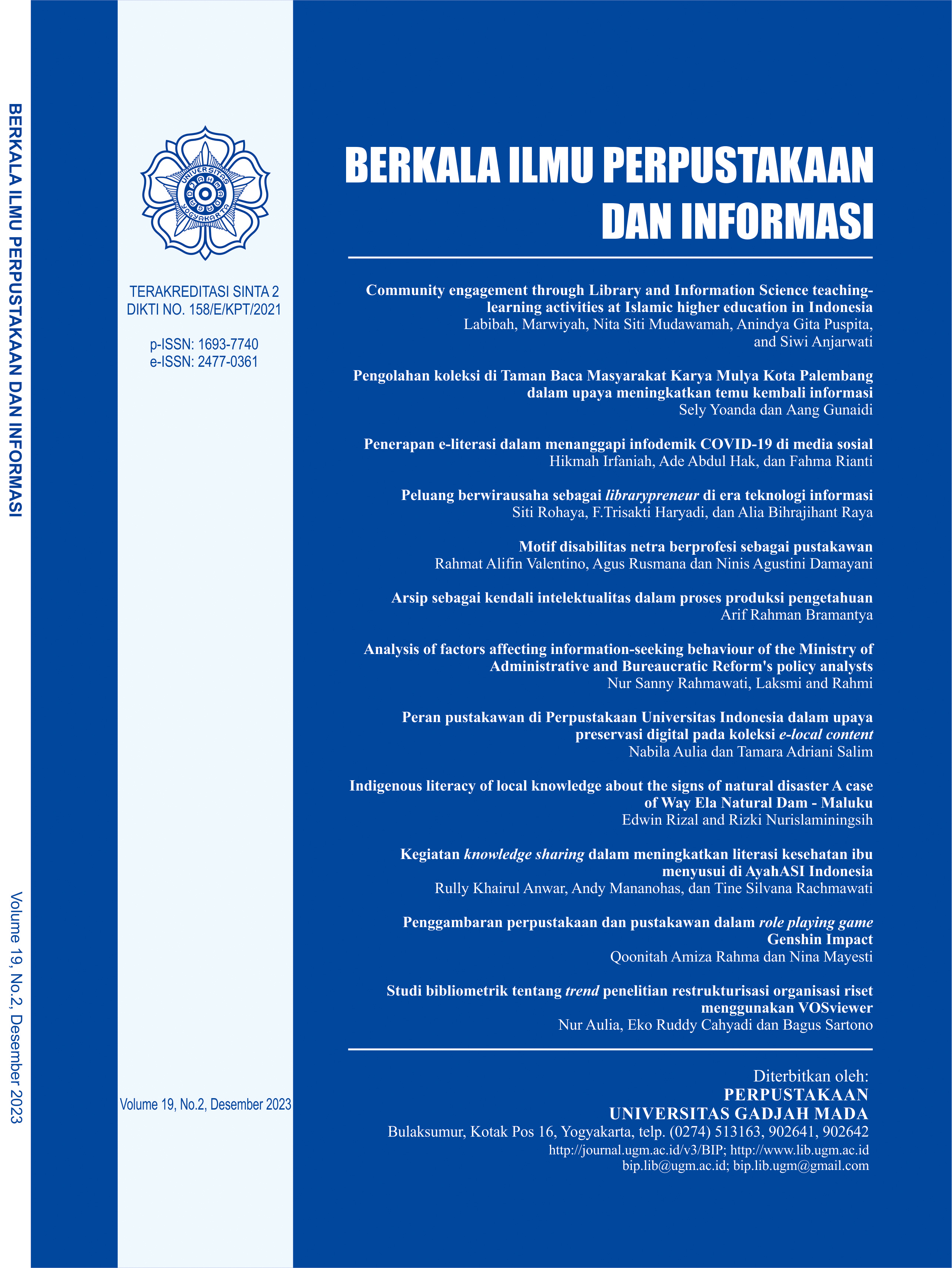Motif disabilitas netra berprofesi sebagai pustakawan
Abstract
Introduction. The number of librarian with disability, particularly with limited ability to see or blind is not many. This research explores the motives of the blind on why becoming librarians.
Research methods. This study used a qualitative research method with a phenomenological approach. Data collection techniques used observations and interviews. Sampling was decided purposively.
Analysis data. Research analysis was conducted through the stages of data reduction, data display, and conclusion drawing. Data validation techniques were carried out using credibility tests.
Results and Discussion. The motive to become a librarian refers to Alfred Schutz's phenomenological theory which can be divided into two categories: motives based on because-motive (Weil-Motiv), namely the hobby of reading, lack of reading material for blind people, and library facilities that support performance for librarians with visual disabilities. Motives based on the in-order-to motive (Um-zu-Motiv) are to change the social stigma of people with visual disabilities, increase readers’ interest in reading, socialize braille collections, increase economic levels, and increase relationships.
Conclusion. The findings show that being a librarian with visual disabilities is oriented towards past and future motives.
References
Anshori, I. (2018). Melacak state of the art fenomenologi dalam kajian ilmu-ilmu sosial. Halaqa: ISlamic Education Journal, 2(2), 165–181. https://doi.org/10.21070/halaqa.
Berger, P. L. (2014). Invitation to sociology. La Découverte.
Bodaghi, N. B., Cheong, L. S., Zainab, A. N., & Riahikia, M. (2016). Friendly librarians: The culture of caring and inclusion experiences of visually impaired students in an academic library. Information Development, 33(3), 229–242. https://doi.org/10.1177/0266666916641178
Bola, Ł., Siuda-Krzywicka, K., Paplińska, M., Sumera, E., Hańczur, P., & Szwed, M. S. (2016). Braille in the sighted: Teaching tactile reading to sighted adults. PLoS ONE, 11(5), 1–13. https://doi.org/10.1371/journal.pone.0155394
Creswell, J. (2016). Research design: Pendekatan metode kualitatif, kuantitatif, dan campuran (4th ed.). Pustaka Pelajar.
Firdiyah, R., & Primasari, W. (2019). Kampanye sosial gerakan menutup aurat di Bekasi. Jurnal Ilmu Komunikasi, 16(1), 89–101. https://doi.org/10.31315/jik.v16i1.2685
Hollich, S. (2020). What it means for a disabled librarian to “pass”: An exploration of inclusion, identity, and information work. International Journal of Information, Diversity and Inclusion, 4(1), 94–107. https://doi.org/10.33137/ijidi.v4i1.32440
Idaini, M. W. (2021). Interaksi sosial kaum difabel netra. Jurnal Pendidikan Indonesia, 2(2), 242–256.
Kuswarno, E. (2015). Fenomenologi: Metode penelitian komunikasi : Konsepsi, pedoman, dan contoh penelitiannya. Widya Padjadjaran.
Mahesh, K., & Gurulingaiah, M. (2021). Persons with disabilities: Issues and challenges. International Journal of Research Publication and Reviews, 2(8), 386–392. https://doi.org/10.55248/gengpi.2021.2.3.1
Manggola, A., & Thadi, R. (2021). Fenomenologi Alfred Schutz: Studi tentang motif pemakaiaan peci hitam polos. JOPPAS: Journal of Public Policy and Administration Silampari, 3(1), 19–25. https://doi.org/10.31539/joppas.v3i1.3111
Badan Pemeriksa Keuangan. (2016). Undang undang Republik Indonesia nomor 8 tahun 2016 tentang penyandang disabilitas, Pub. L. No. 8 (2016). https://peraturan.bpk.go.id/Home/Details/37251/uu-no-8-tahun-2016
Priatna, T. (2015). Filsafat ilmu penelitian kualitatif beberapa catatan tentang pendekatan kualitatif. Digital Library UIN Sunan Gunung Djati. https://digilib.uinsgd.ac.id/9761/
Rahmah. (2020). Penerimaan diri bagi penyandang disabilitas netra. Alhadharah: Jurnal Ilmu Dakwah, 18(2), 1–16. https://doi.org/10.18592/alhadharah.v18i2.3380
Raiz, M. L., & Sahrul, M. (2020). Kompetensi sosial penyandang disabilitas netra dalam dunia kerja. Seminar Nasional Penelitian LPPM UMJ, 1–15. https://jurnal.umj.ac.id/index.php/semnaslit/article/view/7854/4672
Rosner, Y., & Perlman, A. (2018). The effect of the usage of computer-based assistive devices on the functioning and quality of life of individuals who are blind or have low vision. Journal of Visual Impairment and Blindness, 112(1), 87–99. https://doi.org/10.1177/0145482x1811200108
Schutz, A. (1967). The phenomenology of the social world. In Schutzian Research. Northwestern University Press. https://libgen.is/book/index.php?md5=7F9B254178BE77AB2EE29A0DD39FE2D9
Sulthon. (2016). Pola keberagaman kaum tunanetra dan dampak psikologis terhadap penerimaan diri. Quality, 4(1), 45–68. https://doi.org/10.21043/quality.v4i1.2114
Syahputra, A. E. A., & Ismail, Y. Z. (2021). Motif-motif perilaku manusia dalam perspektif al-qur’an (Kajian atas kasus fisiologis dan spiritual). Studi Quran dan Hadis, 3(1), 85–100.
Tumangkeng, S. Y. L., & Maramis, J. B. (2022). Kajian pendekatan fenomenologi : Literature review. Jurnal Pembangunan Ekonomi dan Keuangan Daerah, 23(1), 14–32. https://doi.org/10.35794/jpekd.41379.23.1.2022
Copyright (c) 2023 Berkala Ilmu Perpustakaan dan Informasi

This work is licensed under a Creative Commons Attribution-ShareAlike 4.0 International License.
Berkala Ilmu Perpustakaan dan Informasi is licensed under a Creative Commons Attribution-ShareAlike 4.0 International License.
- Articles published in Berkala Ilmu Perpustakaan dan Informasi are licensed under a Creative Commons Attribution-ShareAlike 4.0 International license. You are free to copy, transform, or redistribute articles for any lawful purpose in any medium, provided you give appropriate credit to the original author(s) and Berkala Ilmu Perpustakaan dan Informasi, link to the license, indicate if changes were made, and redistribute any derivative work under the same license.
- Copyright on articles is retained by the respective author(s), without restrictions. A non-exclusive license is granted to Berkala Ilmu Perpustakaan dan Informasi to publish the article and identify itself as its original publisher, along with the commercial right to include the article in a hardcopy issue for sale to libraries and individuals.
- By publishing in Berkala Ilmu Perpustakaan dan Informasi, authors grant any third party the right to use their article to the extent provided by the Creative Commons Attribution-ShareAlike 4.0 International license.






